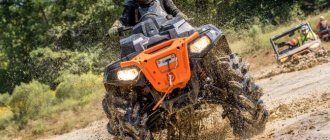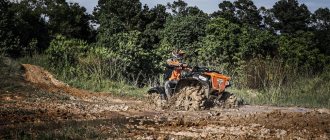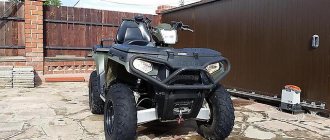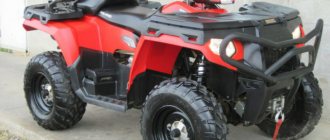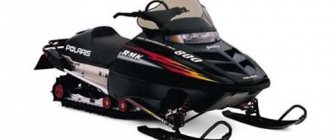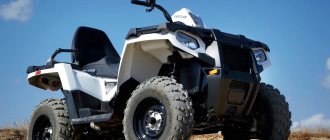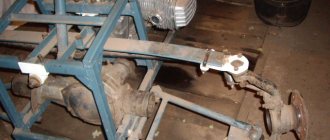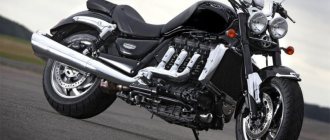Polaris Sportsman 500 is a reliable utility vehicle introduced by the American company back in 2005. The powerful device gained wild popularity , which prompted the manufacturer to release several modifications of the Sportsman.
Line model range:
- Polaris Sportsman 500. This is the basic version of the device, first released in 2005. The car can be called a real all-terrain vehicle; the ATV handles confidently in the forest, on rough terrain and in wetlands. Thanks to the powerful engine, the device can be used for both active recreation and work. One of the main features of the Sportsman is the automatic transmission and fuel gauge.
- Polaris Sportsman 500 Touring. This is not just a workhorse, but a full-fledged touring ATV . After changes made by the manufacturer, the device acquired a more powerful engine (39 horsepower), a passenger seat and a more attractive design. The car performs well both on the highway and on rough terrain.
- Polaris Sportsman 500 EFI. When developing the ATV, the manufacturer placed the main emphasis on power and safety. The new model has acquired a descent control system , disc brakes and an overheating indicator. An interesting solution was the installation of a winch with a traction force of 2500 pounds.
Polaris presented customers with three versions of the Sportsman - Polaris 500 6×6, Mossy Oak and 500 HO. The devices differed in fuel tank capacity, load capacity and equipment.
Winch included
Of course, if you are not going to ride only near your home and nearby villages, but want to get closer to nature, the winch comes included!!! Moreover, the official dealer Brandt Kemerovo on Leningradsky Ave. 28/1 offers a wide range of accessories and additional equipment at attractive prices.
The two-seater Polaris Sportsman 500 Touring ATV has a longer wheelbase than the single one. It's a pleasure to ride.
Specifications
Power point:
- Number of cylinders – 1.
- Working volume – 500 cubic meters.
- Rated output power is 39 horsepower/29 kilowatts (at 5500 rpm).
- The highest torque is 56 newtons per meter (at 4250 rpm).
- Number of camshafts – 1.
- The camshaft location is overhead (SOHC).
- Number of valves – 2.
- Type of cooling system – liquid.
- Type of lubrication system – oil bath.
- Type of fuel system – carburetor.
- Recommended fuel is AI-92.
- The type of ignition system is contactless electronically controlled (CDI).
- Starting system type: electric starter.
Chassis:
- Drive type – full.
- Transmission system type – variator.
- Frame type: tubular steel.
- Clutch type – centrifugal automatic.
- Front suspension type – independent McPherson with horizontal and vertical travel.
- Rear suspension type - independent with A-shaped arms with horizontal and vertical travel.
- The front suspension travel is 208 millimeters.
- Rear suspension travel is 222 millimeters.
- Front wheel tires – 25x8-12.
- Rear wheel tires – 25x11-12.
- Front disc type: stamped steel.
- Rear disc type: stamped steel.
- Front brake type: hydraulic disc.
- Rear brake type: hydraulic disc.
- Power steering type – electric.
Dimensions:
- Structural length – 2184 millimeters.
- The structural width is 1219 millimeters.
- Structural height – 1219 millimeters.
- Seat height – 857 millimeters.
- Wheelbase length -1448 millimeters.
- The lowest ground clearance is 279 millimeters.
- The smallest turning radius is 3200 millimeters.
Other characteristics:
- The capacity of the fuel tank is 15.5 liters.
- The maximum weight of cargo transported on the front trunk is 51 kilograms.
- The maximum weight of cargo transported on the rear trunk is 71 kilograms.
- The curb weight of the ATV is 335.7 kilograms.
And everything is fine with the iron!
As for the technical part, here it is in no way inferior to its competitors. Connectable all-wheel drive, low gear, as well as a hill descent control system. It easily tows a car trailer up to 550 kg; there are quite convenient platforms in front and behind where you can also put everything you need on the road.
And the fuel tank capacity is 15 liters, I note that the baby has a fairly moderate appetite. It’s probably difficult to convey all the sensations that a Sportsman gives you when driving. You just have to try it.
Two-seater “athlete” from Polaris
Its "pedigree" and design
It’s not for nothing that devices of this kind are called “four-wheeled motorcycles.” Enduro bikes are not their distant cousins at all, but their closest “relatives.” Energy-intensive long-travel suspensions, high-torque engines, “toothy” tires with developed lugs allow them to easily move not only on broken and muddy dirt and forest roads, but also where instead of roads there are only directions.
This technique, by the way, is very popular all over the world and attracts more and more fans every year. The secret of this phenomenon lies in its versatility. “Four-wheelers” (or, as they are also called, ATV - All-Terrain Vehicle) are capable of transporting cargo, towing a trailer, and, if necessary, clearing snow in front of the house. Well, with the help of a wide range of additional equipment, many of them can easily turn into almost mini-tractors: all-wheel drive allows you to do a lot.
If you press the accelerator lever well, you can get real pleasure from driving. The motocross track is, perhaps, for a special subspecies of ATV, uncompromising racing models, but you can go through the forest paths and rush around the surrounding fields to your heart's content even on utilitarian models.
The Sportsman X2 500 EFI belongs to such multifunctional four-wheelers. In the Polaris model range of all-terrain vehicles, the Sportsman family is allocated, in fact, to a separate class and occupies a niche between sports and utilitarian models and represents a kind of symbiosis of the best qualities of representatives of both classes.
X2 is the first 2-seater model in the line (hence the name). Moreover, the back of the rear seat can be folded, and in this case the rear trunk will increase slightly. By the way, partly for reasons of passenger safety, the ATV was equipped not with the most powerful 800 cc, but with a 499 cc single-cylinder 4-stroke liquid-cooled engine with a power of 49 hp. With. Not enough? For a device with a dry weight of 362 kg - just right. In case anyone has forgotten, quite recently other small cars were equipped with engines of similar power...
The gearbox is a proprietary automatic V-belt variator PVT (Polaris Variable Transmission), interlocked with the transfer case. The latter has a reduction gear with a gear ratio of 23.91:1. The gearbox is equipped with reverse. Torque is transmitted to the wheels by cardan shafts; Moreover, the driver is at any time free to choose between all-wheel drive, 2x4 and automatic mode, when the 4x4 drive is activated independently if necessary.
The device’s suspension can easily be called “automotive”: McPherson struts at the front and a completely independent design at the rear. “Something sounds familiar,” doesn’t it? Not every car, however, has suspension strokes reaching 22 cm. Just as not every SUV is now equipped with a transmission with a reduction gear and manually activated all-wheel drive.
Well, we had to find out during the test how this whole construct works in practice and how successful the compromise between sporting and utilitarian qualities was found by the developers.
"Across the valleys and the hills..."
We decided to conduct filming and test runs near the village of Koltushi. We found a quiet, picturesque corner: a couple of small lakes, a winding dirt road winding between them, sandy ravines and slopes, an almost flat field - there was a place to have a good time and test our “Sportsman” in combat mode.
Control of the device is organized simply and intuitively. The engine starts electrically, but just in case there is a backup (with a starter cord). Under the left hand there is a handbrake and a low/high beam switch, under the right hand there is a switch for drive modes and an accelerator lever under the thumb. Transmission modes are activated by a lever located on the right side of the device body. It is 5-position: H/L/N/R/P (respectively, “upshift”, “downshift”, “neutral”, “reverse” and “park”).
The ATV starts moving, at first glance, lazily: more precisely, with a second delay necessary for the engine to spin up a little and “grab” the variator. But after that - no “thinking”. Gas - and the device “tears its soles”! Moreover, once you get the hang of it, the traction force can be dosed very precisely: start smoothly if there is loose sand, dirt, or clay under the wheels; or actively, with slipping, if you want to come off in full.
The Sportsman also reacts to steering inputs without any hesitation. It easily enters turns without struggling, tenaciously holds the trajectory and accelerates powerfully at the exit. True, it rolls mercilessly: the suspensions are long-travel, the center of gravity is located relatively high, and the overall height of the model, do not forget, is equal to its width. But if, when going through a turn, you lean into the bend ahead of time, then all the attempts of the vehicle to capsize are nipped in the bud, and instead it begins to slide outward with its rear wheels, allowing, after a short training, to take turns in a spectacular slide.
While the photographer and I were choosing places and angles for shooting, we also managed to check what it was like for the rear passenger in the Sportsman. As it turned out, it’s quite good: the back seat is comfortable, the backrest is optimally shaped, and there are a couple of convenient handles, very well located. But before setting off on a trip together, it would be a good idea to instruct the passenger so that when cornering, he and the driver lean into the bend.
Well, what about the X2's cross-country ability? There was no place to take a “mud bath,” but we managed to test it in the sand. The Sportsman overcomes medium-steep inclines effortlessly - you don’t even need to engage all-wheel drive, much less lower gear. Feeling emboldened and also realizing the remarkable capabilities of the device, I choose a steeper slope and decide to try to get out of a small ravine. There is dry sand under the wheels. I set the selector on the steering wheel to the “2x4” position, the lever to “L”. Go!
I start from a standstill and don’t really accelerate before the slope to make the task more difficult. Busily grumbling the engine, the Sportsman confidently, without unnecessary tension, drives up, requiring only a slight addition of gas at the very top of the climb. Shine!
The only fly in the ointment was found during frequent switching of transmission and all-wheel drive modes: the gearshift lever and the switch on the steering wheel had low information content. The forces on them are somewhat uncalibrated, and therefore the most common mistake when switching is “overshooting” the desired position. For example, I often turned on “neutral” instead of “reverse” and automatic all-wheel drive instead of “2x4”. Perhaps this is a matter of habit, but during the test I never managed to get used to it.
However, in all other respects, the Polaris Sportsman X2 500 EFI showed its best side: excellent handling and maneuverability, combative, “incendiary” character. It seems that it will suit a wide range of buyers: from summer residents to hunters and fishermen - in general, for lovers of outdoor activities. Behind the wheel of the Sportsman X2 it becomes very, very enjoyable.
Second full seat
It's comfortable to drive both tall and not so tall. The instrumentation is easy to read both in the sun and at night. But the main highlight of the Touring, which distinguishes it from its single-seat brothers, is the second, full-fledged seat.
There is also the Sportsman 550 X2, Sportsman 850 X2, but the second seat is not large because “X-second” is more designed to transport a passenger from point A to point B, and is positioned on the market as an assistant in the household. Indeed, thanks to the box at the back, it is more versatile.
It is worth noting that the second seat on the Sportsman 550/850 X2 is not at all large. but thanks to the box at the back it is more versatile.
